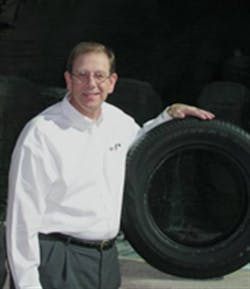If all the pressure of Goodyear Tire & Rubber Co.'s turnaround in North America is on Jon Rich, he doesn't show it, at least in the public eye.
Rich, president of Goodyear's North American Tire operations, was calm and confident talking to his customers at the 2004 Goodyear Dealer Conference in Kissimmee, Fla. He talked about cost-cutting initiatives both good ("tens of millions of dollars" in savings from the Six Sigma quality improvement program in 2003) and necessary (eliminating 4,200 jobs). "This year, we'll add lean manufacturing to our Six Sigma efforts," he said.
He introduced a new fill-rate program, OTIFNE (pronounced "O-tiffany," for On Time, In Full, No Errors), which includes a ship-to promise date. And he emphasized how important it was for Goodyear to increase manufacturing efficiencies, which will include taking advantage of low-cost manufacturing from other sources. "For us to compete, we're going to have to leverage our global assets."
In an exclusive interview with Modern Tire Dealer, Rich said the importance of the independent tire dealer channel to Goodyear could not be overemphasized. "The dealers really have been the catalyst of our turnaround so far."
MTD: Why are independent tire dealers so important to Goodyear's success?
Rich: Tires are sold, not bought. That was one of the first things I learned from independent tire dealers.
When you think about all the products that you buy, tires are a very sophisticated purchase. And without a really knowledgeable behind-the-counter salesperson, I don't think most people get the tire that's really best suited for them.
I recently stopped out to see Dennis Leipold (of Leipold Tire Co.) in Cuyahoga Falls, Ohio. The guy's selling 70 or 80 tires a day! It's not a fancy layout. His service people behind the counter are just tremendous. And you see the same thing with a guy like Fred Allen (of Allen Tire Co. in Lakewood, Calif.). They focus on the expertise of the selling side and they have great service. That's why they get such great repeat business.
MTD: Why are the new Assurance tires being introduced into the marketplace through the tire dealer channel?
Rich: The independent tire dealer channel for us still represents the largest chunk of our business. I think they're the ones who, because of the selling expertise that they have, can most rapidly sell the value of Assurance.
That's not to say our other great customers can't do it, but we want to try and sell (the value of Assurance) as quickly as we can.
As I talk to independent dealers, I firmly believe the clientele that goes into a mass merchandiser is looking for something totally different. Those customers are not going to go to the independent tire dealer anyway. And they are probably not going to get the absolute best product for their fitment. Now, I do think mass merchandisers are getting much better. They (just follow) a different model.
MTD: Tire shipments were higher than normal the last two months of 2003 and in January of this year. How will implementing the new OTIFNE program help?
Rich: We're not the first ones to do it. Traditionally, fill rates are measured by what you ship out vs. orders. Customers don't care about that. If a customer orders a hundred tires and 20 go into backorder, they don't care if we call the 80 a 100% fill rate. We've got to get much more aggressive in serving customer needs from a fill-rate standpoint.
Actually, we made real good progress, but then in the last two months of last year, business picked up faster than we expected. It's a problem we need to fix. We have to stay focused on that. The economy is turning around, and everybody's seeing the tide come in and raise the boats up. And that's good for everybody. If business is good, you're selling a lot of tires. You may be out of some tires and miss some sales, but it's not as bad as people not coming in to buy.
MTD: Not unless demand turns out to be a lot greater than supply.
Rich: We're not going to have that. (Manufacturers) are adding capacity in China without any consideration for demand. Demand in China is going to pick up, but they're racing out in front.
Sales of Asian imports in 2003 went up 12% in the U.S. That means for us to compete, especially in the price sensitive areas, we're going to have to leverage our overseas assets. That's what I talked about to the dealers. And we're going to do that.
MTD: How about a cost-cutting update?
Rich: We made good progress in 2003. Some of the steps we made were very, very difficult, especially the labor cutbacks that we had. Closing the plant in Huntsville (Ala.) was a difficult step. But they were necessary. We had to do it.
Our labor agreement gives the union workers some incentives to cooperate together with us to drive productivity, and we're pushing that very hard. There is a joint effort to make that happen because when you see the excess capacity in China, we're not competitive.
I firmly believe that North American tire manufacturing can be competitive, and I'm committed to that. We're going to have to work hard together because the enemy is not management or labor.
MTD: Doesn't Goodyear have manufacturing in China?
Rich: Sure, and we'll leverage our assets where we need to. But I'd much rather make ourselves competitive domestically, because I closed a factory last year, and it's no fun. I don't want to do that.




